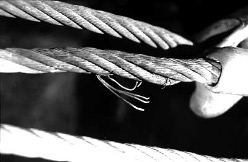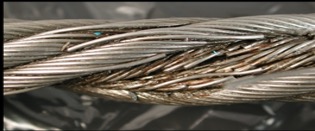
Dangers:
Damage from wear and tear can reduce rope strength and capacity, endangering workers who rely on the rope.
Identify Controls:
Wire rope in continuous service should be inspected during operation and at least once a week. There are warning signs to look for during inspection. Most of these warning signs indicate the rope should be replaced.
Broken wires
Replace rope if there are:
- 6 or more broken wires in one lay
- 3 or more broken wires in one strand in one lay
- 3 or more broken wires in one lay in standing ropes

Worn/abraded wires
Replace rope if outer wires:
- Become flat from friction
- Become shiny from wear AND
- Wear exceeds 1/3 of diameter
Reduced diameter
Replace rope if wear on individual wires exceeds 1/3 of their diameter.
Stretch
Replace 6-strand rope if stretch reduces diameter by more than 1/16.
Corrosion
Difficult to detect because it’s inside the rope. Look for rust, discolouration, and pitting outside.
Cuts/burns
Replace rope if any wires or strands are cut or burned. Damaged ends can be removed and seized. Otherwise rope must be replaced.
Birdcaging
Look for strands opening up in cage-like clusters. Rope must be replaced.
Core protrusion
Replace rope when inner core starts poking through strands.
Kinks
Kinks seriously reduce wire rope strength. Sections with kinks should be cut off. Otherwise rope must be discarded.


